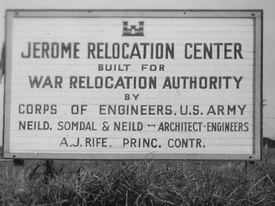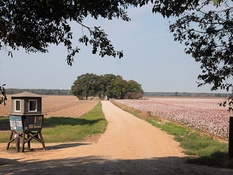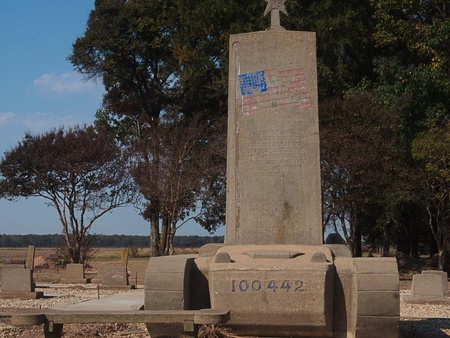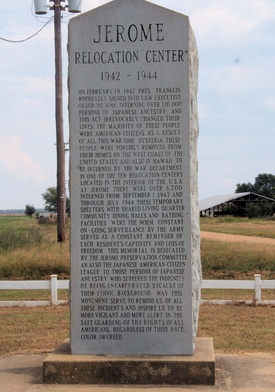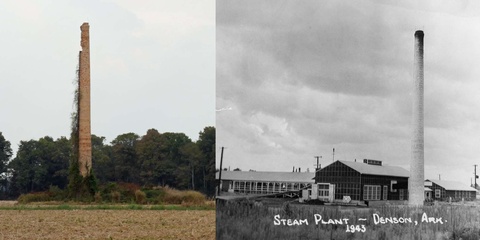Otousan, Obasan, Ojisan, how was the train ride?
My father, aunt, uncle, and their family traveled about 2,000 miles by train from the Fresno Assembly Center in California, where they were first incarcerated, to the Jerome War Relocation Camp, which was open from 1942 to 1944.
More than 70 years later, my wife and I traveled nearly that distance from our Northern California home to Little Rock, Arkansas, where we had been invited to an event at the Clinton Presidential Library.
Our trip by air and rental car undoubtedly took much less time and was more pleasant than my relative’s train trip. Their trip during the fall of 1942 would have taken several days in railroad cars without air conditioning. They were guarded by soldiers and were told to pull the curtains down to keep them from seeing out. As I was told, “We just sat there. We couldn’t see nothing…All you could see was the inside of the train.”
While in Arkansas, I wanted to visit the sites of the Rohwer and Jerome camps, which were over 100 miles southeast of Little Rock and within 30 miles of each other. I wanted to imagine what my father and relatives saw when they arrived, to retrace their footsteps in what would have been a strange land and to “feel the ghosts of the past.”
Both Rohwer and Jerome were southeast of Little Rock, not far from the Mississippi River. As we drove away from Little Rock, the countryside began to remind me of parts of the San Joaquin Valley of my childhood. There were a few small towns sprinkled along the highway, similar to how towns grew up along the old Highway 99 that bisected California’s Central Valley from Bakersfield in the south to Red Bluff in the north. There was flat land in all directions with a farm house appearing every so often. Off the highway, we were as likely to run into a tractor or harvester as another passenger car. In the distance was the Mississippi River, though we could not see it through the clusters of trees that were between it and us.
Driving south on Highway 1, we found the site of the former Rohwer Relocation Camp marked by a road sign announcing “Rohwer Japanese American Relocation Center.” We made the turn off the highway onto a dirt road that led into a field of cotton. Just over a tree-lined berm, there is a kiosk that introduces the site. Mostly what remains of the original site is the area around the cemetery, which has been restored and is maintained as an Arkansas State University Heritage Site.
Rohwer was home to as many as 8,500 people from September 1942 through November 1945. Actor George Takei and his family were incarcerated there. Recently George said that when he returned to Rohwer for the first time and saw the cemetery, he was moved by “a crumbling concrete pylon and at the base were the names of all the young men who went from behind those barbed wire fences, drafted into the army and fought for this country…”
Between Rohwer and Jerome is the town of McGehee, home to former mayor Rosalie Santine Gould. Miss Rosalie, as she is known, was instrumental in preserving artifacts from Rohwer. We had met her the previous night at the premiere of Relocation, Arkansas, a documentary by filmmaker Vivienne Schiffer, who is also Miss Rosalie’s daughter. Relocation is partly about the impact of incarceration on Japanese Americans, some of whom chose not to return to the West Coast after WWII, and partly about Miss Rosalie’s efforts to preserve the history of the camps in Arkansas.
McGehee is also home to the WWII Japanese American Internment Museum where we met Susan Gallion, museum curator. The Museum has a small, but important, collection of photographs, stories, and artifacts from the camps that might not have otherwise been available to residents and tourists.
We left McGehee and drove south towards Jerome, which like Rohwer was situated on about 10,000 acres of swampland in the Mississippi River floodplain. It was the last camp to open in October 1942 and at its peak held about 8,500 Americans of Japanese descent.
Otousan, Obasan, Ojisan, did you see the smokestack when you arrived at Jerome?
As we came within a few miles of the town of Jerome on State Highway 165, a tall, thin structure came into view to the southeast. Just a few minutes more and on the east side of the highway, we found the monument to the Japanese Americans who were incarcerated in Jerome. Driving at highway speeds, you would miss it if you blinked.
Upon their arrival, my family would have seen forested swampland, barracks, administration buildings, and steam plant smokestack. They would have collected their baggage and gotten an apartment assignment. And, as one relative told me, they asked “Where’s the shower?” They were desperately in need of a bath or shower after days on the train.
Now as my wife and I scanned the area, the barracks, hospital, and administration buildings were all gone. Jerome once had over 400 barracks arranged in 36 blocks on about 500 acres. Those 500 acres were now occupied by a sod farm.
Since the site is now a working farm, one cannot just drive onto it. Fortunately, the driver of a semi loaded with just harvested sod had stopped to refuel nearby.
“Y’all are welcome. Y’all can take as many pictures are you like,” said the man after I had walked over to him to ask if I could take pictures.
We drove down a dirt road into the farm towards the remains of a concrete water storage tank, which was part of the pump station.
But what was that tall, thin structure? It was the crumbling smokestack of what used to be the steam plant.
In the distance to the east, I saw some weed covered structures and wondered if they were also remnants of the camp. However, within a few short minutes, dark clouds rolled in and a sprinkle turned into deluge. We were forced to retreat back to the car and head back to Little Rock.
Otousan, Obasan, Ojisan, what was it like sitting in the barracks listening to the rain pelting the tar paper walls?
They undoubtedly noticed that the climate was more severe than in Central California, hot and humid in the summer and cold with possible snow in the winter. Certainly it must have been frightening and exciting to them.
Otousan, Obasan, Ojisan, how was the train ride to Arizona?
Jerome was the first camp to close in June 1944. My father, aunt, uncle, and their family left Jerome for the Gila River concentration camp in Arizona.
Safely back at our hotel, I tried to describe to myself how I felt. In reality, I didn’t have an emotional reaction to our short visit to the camps. I didn’t feel the “ghosts of that past time, of the people who died there, labored there, and were born there.” Without human reminders of those times, I was just an isolated observer of those lonely ruins.
Author’s note: This is the third story that I have written about incarceration and Jerome: the first two were “Will We Feel the Ghost of the Past at Jerome?” [Pacific Citizen 2011 Holiday Issue, reprinted on Discover Nikkei on January 23, 2012] and “All My Friends, They Went to Tule,” [Discover Nikkei on February 19, 2013).
© 2016 Ben Arikawa


